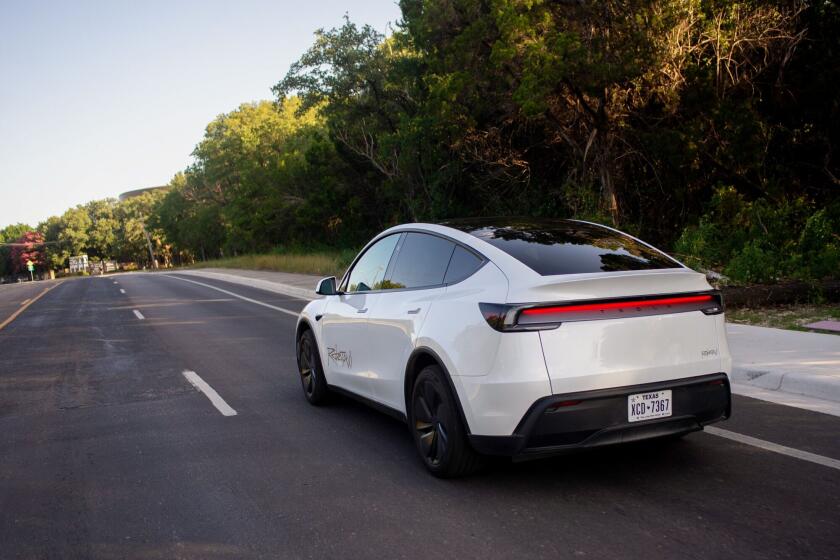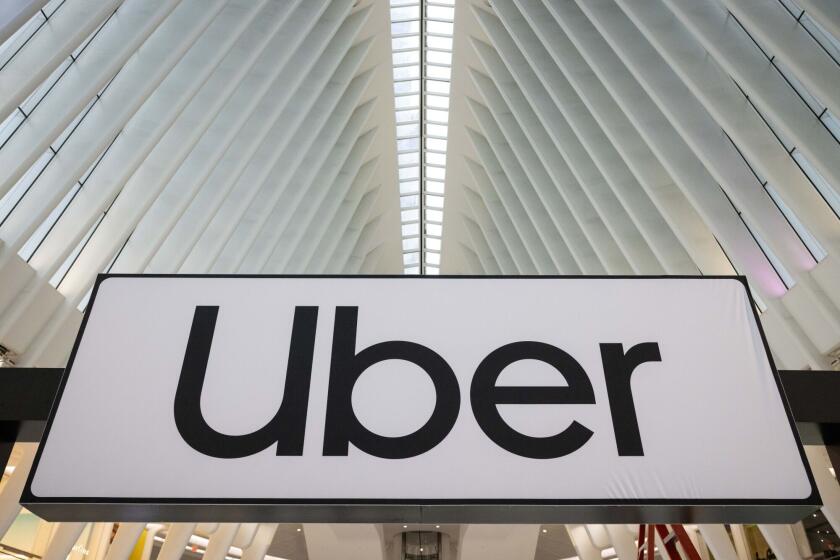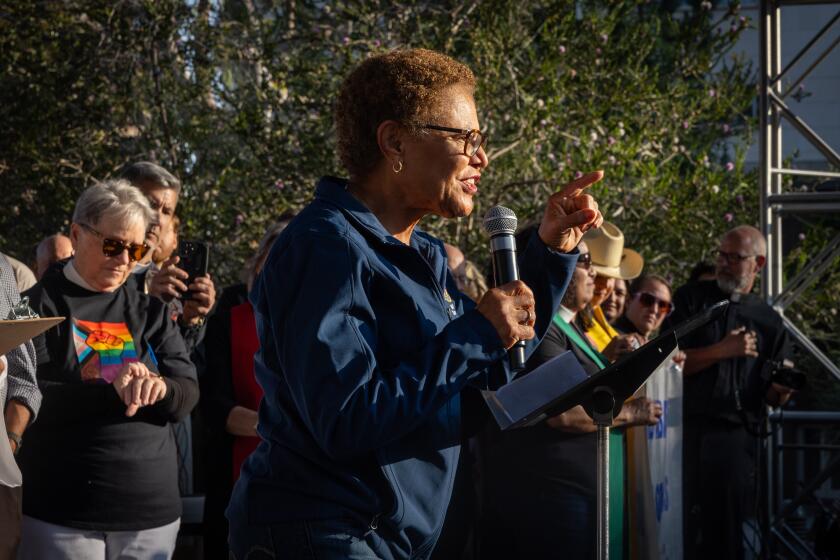Fast Tracks for Freight : Railways See New Express Services as Tickets to Success
- Share via
It was nearly 4 a.m., and the outskirts of San Bernardino ahead were pitch black as engineer Alvin Wolfe, one hand on the brake and the other near the throttle, eased his westbound express freight train down the steep grade from the Cajon Pass.
Between Barstow and Victorville, his train, providing the fastest transcontinental freight rail service ever scheduled, had hurtled along at 70 miles per hour. But now Wolfe, wearing a yellow corduroy cap with the words “Santa Fe” stitched in red, kept the train’s speed down to 24 m.p.h.
“If your wheels warm up, your brake efficiency goes way down,” he explained. Ten feet off the ground in the yellow diesel-electric locomotive’s cab, progress seemed glacial.
Despite the pre-dawn hour, Interstate 15--paralleling the tracks--was clogged with trucks, a long line of red dots in the dark. The trucks were pulling ahead, but Wolfe refused to ease up on the brake. “There they go, unsafe at any speed,” he said ruefully, making a typical railroad worker remark on the safety of anything that can haul less than a thousand tons.
Since Congress began deregulating the trucking and railway industries in 1980, trucks have been gaining on trains in hauling U.S. freight. Railroad executives hope that recently launched express freight train services such as Santa Fe’s, begun in late July, may help them recapture lost business.
According to the Assn. of American Railroads in Washington, trucks hauled 25.1% of U.S. intercity freight tonnage last year, up from 22.3% in 1980, while the market share for trains has fallen to 35.8% from 37.5% in the same period. At the same time, the railway industry’s average revenue for hauling a ton of freight one mile has slumped from a peak of 3.212 cents in 1982 to a crippling 2.921 cents last year.
“The pressure on rates is almost unbearable because of the trucking competition,” said Isabel H. Benham, president of Printon, Kane Research, a Manhattan railroad consultant.
In the past two years, however, all of the nation’s largest railroads have fought back by starting fast freight train services aimed at winning business from the trucking industry--by carrying the truck trailers “piggyback” on flatbed rail cars, or even buying so-called RoadRailer truck trailers with hydraulically lowered railway wheels.
“Premium piggyback” and RoadRailer trains are intended to haul freight over distances of as little as 200 miles, and with greater punctuality, less damage, and at a lower price than trucks can offer. In place of such cheap, bulky, traditional railroad shipments as coal and grain, the trains are carrying small, valuable products--everything from mail parcels and cigarettes to television sets, glass bottles and computers.
Premium piggyback trains have benefited from concessions by the powerful railroad unions and have three other distinguishing characteristics: fewer cars, tighter schedules and preferential treatment by train dispatchers.
Damage-Free Delivery
Fragile goods in trailers suffer less breakage when carried aboard short trains composed entirely of 20 or 30 flatbed cars, because the cars swing back and forth less when rounding curves. Products in flatbed cars coupled to tankers full of sloshing liquids used to sustain substantial damage, said Clarence W. Gooden, vice president and general manager for operations of CSX’s intermodal division. “Some railroads thought a car coupled to another car didn’t care what was in the car next to it.”
“Everybody talks about this rock and roll, and bump and grind,” said Mark S. Cane, Burlington Northern’s intermodal marketing director. The company’s Expediter service guarantees 99% damage-free delivery, carrying such products as television sets from Zenith’s Springfield, Mo., factory.
Tighter schedules mean accepting trailers practically until the train leaves and charging the shipper based on the number of hours within which the goods must be delivered.
Santa Fe’s daily, 76-hour express transcontinental service from Los Angeles--Conrail operates the Chicago-to-New York leg--accepts trailers until 4:30 p.m. for departure between 5 p.m. and 6 p.m., and costs 10% to 20% more than conventional piggyback service. Burlington Northern, Santa Fe, Union Pacific and CSX all claim that their premium piggyback trains arrive on schedule at least 95% of the time.
Dispatchers clear the tracks in front of premium piggybacks, ordering other freight trains onto sidings. “Basically when you have a (premium piggyback), everything gets out of the way. You don’t have a work gang out in front pulling up the rails,” Santa Fe spokesman Michael A. Martin said.
Still controversial is whether these services are making money and whether they are simply taking business from other freight trains rather than from the trucking industry. “Most of the railroads continue to complain of the profit margins” in hauling truck trailers and containers, said Graeme A. Lidgerwood, a railway analyst for the investment firm of First Boston. But she added that while premium services may be taking some loads from other freight trains, “I do believe that there’s been some diversion (of cargo) from the highways.”
Trucking officials play down the effect. “The majority of piggyback traffic came out of boxcars, so it was the railroads stealing from the railroads. . . . Most railroads haven’t made a dime out of piggyback,” said Lana R. Batts, vice president for policy of the American Trucking Assn., headquartered in Alexandria, Va.
While refusing to give precise figures, railway officials argue that the new train runs are profitable, and that most of their business otherwise would go on trucks. “For the year 1987 to date, we’re well above the break even, and it’s not a few dollars, it’s a large amount,” Santa Fe assistant vice president for traffic John A. Grygiel said of his company’s year-old Quality Service Network.
So-called piggyback trains have been around for decades, but the volume of traffic on them has surged 64% in the past six years, thanks to technological innovations, deregulation, union concessions, the worldwide growth of intermodal transport--moving containers or trailers by more than one means, such as by ship and then truck--and the advent of premium services.
Piggyback trains are not a panacea. To make money, they require routes with a balanced two-way flow of traffic, Benham said. Santa Fe has already discontinued Quality Service Network service to Phoenix because the large volume of goods going to the city was not matched by a similar outflow--not unusual for high-tech and service-based urban economies.
Besides Burlington Northern, Union Pacific, CSX and Santa Fe, Norfolk Southern, Conrail and Southern Pacific have all entered the premium piggyback or RoadRailer market in the past two years.
Burlington Northern, headquartered in Fort Worth, launched its 17-city Expediter short-haul network in October, 1985, and has seen monthly traffic rise to more than 19,000 units from fewer than 3,000 trailers and containers, Cane said. Expediter trains have come to account for 30% of the company’s intermodal freight operations, which in turn are up 15.9% this year, he said.
Chicago-based Santa Fe inaugurated its eight-city Quality Service Network in October, 1986, and has raised weekly traffic to 1,500 trailers and containers from 300, Grygiel said. “The effort there was to get back some shorter-haul movements in our territory in the Southwest, where the motor carriers had taken over almost all the time-sensitive movements,” he said, claiming that Santa Fe has increased its market share to 5% from 0.5% in a year.
Southern Pacific, headquartered in San Francisco, has expanded its Sprint service to 14 from 2 cities since spring, 1985. Omaha-based Union Pacific started its Sprint piggyback service in May, 1986, with a route between Portland and Seattle and has since added a New Orleans-to-Dallas route.
Philadelphia-based Conrail operates several premium piggyback mail trains, while Norfolk Southern, headquartered in Norfolk, Va., started a six-city RoadRailer network in July, 1986, charging 15% to 20% more than it does for its regular piggyback service.
High Labor Costs
Baltimore-based CSX in May launched a RoadRailer route between Detroit and Atlanta. The company also handles 33% of Florida’s northbound perishable produce shipments, once carried entirely by trucks, with its 5-year-old Orange Blossom Special piggyback train, one of the earliest experiments with premium piggyback services, CSX’s Gooden said.
The financial footing for all these train services rests upon union concessions. Union work rules up to a century old require crews of four or more to be changed every 100 miles for most freight trains. But modern trains seldom require more than a crew of two, and trains offering premium services, running at speeds of up to 70 miles an hour, can cross a traditional crew territory in two hours.
A senior railroad engineer can earn an annual salary of $45,000 while working 104 hours a month. Labor costs were equal to 44.4% of the railway industry’s total revenue last year, a spokeswoman for the Assn. of American Railroads said.
Hit by layoffs as total employment in the railroad industry shrinks, locals affiliated with the United Transportation Union have agreed to crews of three for the Santa Fe’s Quality Service Network and crews of two for Burlington Northern’s Expediter and Southern Pacific’s Sprint trains. Premium trains now travel as much as 200 to 300 miles between crew changes, even 389 non-stop miles on the Orange Blossom Special leg between Florence, S.C., and Richmond, Va.
Granting the concessions has generated 85 jobs at Santa Fe, while provoking some complaints from union members who live near bypassed crew change points, said Merlyn R. Hicks, a UTU regional general chairman in Kansas City. “Some of the men have to drive 100 miles to get there, and then ride back through their home terminal,” he said.
But union members may have little choice but to make concessions, First Boston’s Lidgerwood said. “I don’t think there’s anything more crucial to the railroad industry than changes in work rules. It’s a really bleak situation if they don’t get some changes.”
Faster Travel
Premium services have also benefited from the complete deregulation of all piggyback train rates in 1981--allowing fares to be adjusted daily to market conditions--and the introduction of giant, $500,000 cranes that can lift a 35-ton trailer on or off a flat car in just two minutes. A decade ago, rail yard workers loaded flatbed cars by driving each trailer up a ramp and down the length of the train, a process that could take a full day or more for a long train. Up to two-thirds of all flat cars now in service can be loaded only by crane.
The faster loading has helped trains compete to carry urgent cargoes on shorter routes. “It used to be if it was under a thousand miles, you didn’t even consider it for rail movements,” Grygiel said.
The speed and tighter schedules of modern freight trains have accelerated the pace of life for train crews. Trainmaster E. J. (Mike) Mulligan, a Santa Fe engineer with 37 years of experience who recently rode Wolfe’s train, recalls stoking steam engines in Southern California as an apprentice.
Freight trains took as long as 10 days to travel from Los Angeles to Chicago then, he said. “There was no schedule on a (freight) train in those days. When you got there, you got there.”
The new transcontinental freight makes the Chicago-Los Angeles leg in less than 48 hours.
More to Read
Sign up for Essential California
The most important California stories and recommendations in your inbox every morning.
You may occasionally receive promotional content from the Los Angeles Times.













